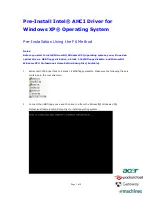
Application Analysis
SECTION 16 Application Analysis / Performance Monitor
236
16-1-1 Data Analysed
This following information explains what data will be analysed when the
'Analyse Application' feature is run.
Summary Tab
The 'Summary' tab provides an overview of the
application data including any warnings or errors found.
Warnings Tab
The 'Warnings' tab identifies specific problems found with
the application and may offer suggestions for resolving
the problems.
It many cases, it will also be possible to go straight to the
source of the problem by accessing the popup menu
associated with the item, allowing the problem to be
resolved directly from the 'Analyse Application' dialog
box.
Network Tab
The 'Network' tab provides information specific to the
selected network configuration. Where more than one
network is configured, each network can be selected
independently from a drop-down list.
PLC Tab
The 'PLC' tab provides information specific to the
selected PLC. Where more than one PLC is configured,
each PLC can be selected independently from a drop-
down list.
Pages Tab
The 'Page' tab provides information specific to the
selected page. Where more than one page is configured,
each page can be selected independently from a drop-
down list.
Always Updating
The total number of points that are always
updating whether they are on display or not - this
should be kept to a minimum to reduce bandwidth
use - only use this if the point value is required by
scripts or other actions on pages where this point
is not otherwise used.
Always Updating %
The percentage of points that are always updating
- this should be reduced in favour of update on
display
Always Updating Bytes/
Sec
This is a count of points that are set to Always
update at the specified rate. It is best to have a
small number of different update rates as this
helps CX-Server to optimise. Whilst good to have
a low number of different update rates it is also
worth remembering that the more updates per
second the more bandwidth is used.
Inputs On Request
The total number of inputs that are on request.
These are potentially less efficient than an 'on
interval' - a single point being requested is not
optimised by CX-Server when sending to a PLC
many points at the same interval can be sent in the
same message with negligible overheads.
Summary of Contents for CX-Supervisor
Page 1: ...CX Supervisor Software Cat No W10E EN 01 User Manual Software Release 3 1...
Page 3: ...Copyright Notice 2...
Page 16: ...15...
Page 17: ...16...
Page 27: ...Tip of the Day SECTION 1 Graphics Editor 26...
Page 35: ...CX Supervisor Preferences SECTION 2 Pages 34...
Page 79: ...Responding to Events SECTION 5 ActiveX Objects 78...
Page 115: ...Printing the Graphics Library SECTION 7 Graphics Library 114...
Page 181: ...Data Logging SECTION 11 Data Logging 180...
Page 201: ...Examples SECTION 12 Databases 200...
Page 243: ...Performance Monitor SECTION 16 Application Analysis Performance Monitor 242...
Page 253: ...Using with Omron s CX Server OPC SECTION 17 Using CX Supervisor as an OPC Cli 252...
Page 259: ...Creating a CX Supervisor Client application SECTION 18 Connecting to a remote CX 258...
Page 263: ...Adding a Point Linked to a Parameter SECTION 19 Connecting to Omron Industrial 262...
Page 271: ...Data Logging SECTION 20 Best Practices 270...
Page 275: ...Configuring a Server PC running Windows NT or 2000 Appendix A Configuring a PC 274...
Page 277: ...Appendix B Frequently Asked Questions 276...
Page 296: ...Appendix B Frequently Asked Questions 295...
Page 297: ...Appendix B Frequently Asked Questions 296...
Page 298: ...Appendix B Frequently Asked Questions 297...
Page 299: ...Appendix B Frequently Asked Questions 298...
Page 333: ...Revision history 332...















































